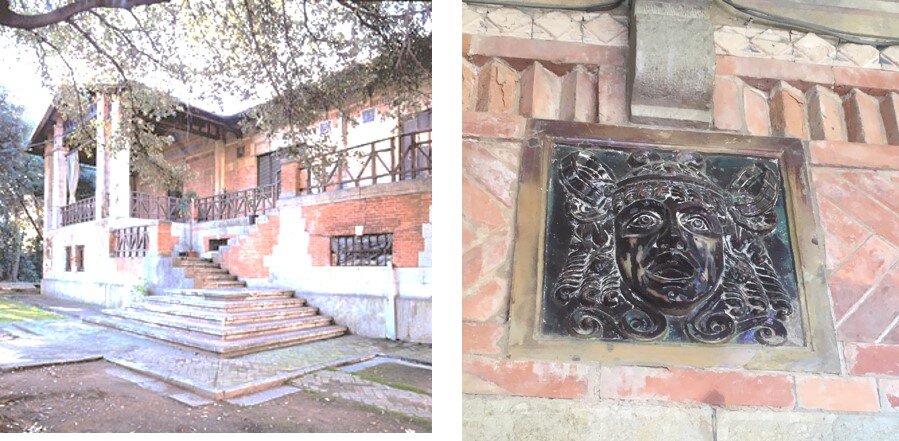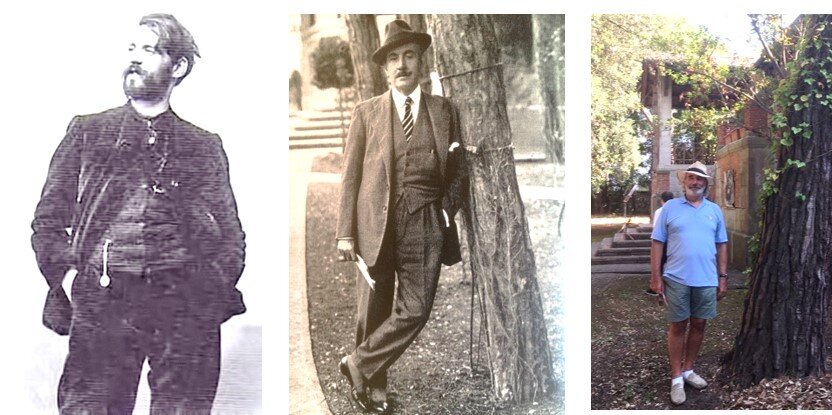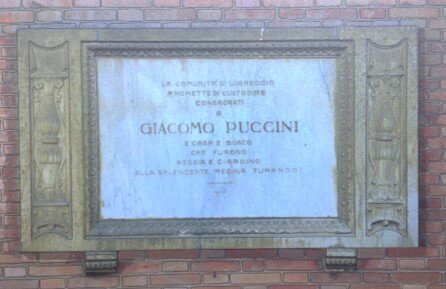Villa Puccini, Viareggio
13 July 2019
Puccini’s villa in Viareggio, initially inherited by his son Antonio and then into private ownership, has finally just recently been acquired by the Puccini Foundation. Luigi Vianni from the Puccini Museum in Lucca informed us that over the next two years the villa will be restored and renovated to its original beauty and open to the public. I, together friends Eddie and Karen, were able to visit the villa that open only for a couple of weekends in July, since it is presently in a bad state of repair. However, there was enough, both inside and outside to feel the presence and the lifestyle of Puccini in his last few years.
The villa, built on land purchased by Puccini in 1915, is close to the lungomare promenade and the beach and overlooks the pine woods on Via Buonarotti. Large surrounding buildings, now mostly hotels were typical of the era and testify to the advances Viareggio had made to become a desirable, elegant and wealthy seaside town. This was different to Torre del Lago, that remained a quieter, less prosperous area further south along the coast.
The two-storey villa has a well-organised layout, designed specifically around Puccini’s lifestyle by friend and architect Vincenzo Pilotti, a professor at Pisa University and the engineer Federigo Severini. The ground floor contained the kitchen, servants’ rooms, service and laundry areas, Puccini’s office and at the south-eastern corner the maestro’s music room that used to contain his famous Steinway grand piano, now in the Puccini Museum in Lucca.
On the second floor were three central-heated bedrooms, all with separate vividly coloured bathrooms: one for his son Antonio; one for his wife Elvira and one for the maestro himself, that contained a small private staircase down to his ground floor music room. Puccini composed Turandot here, where he liked to work quietly at night. The music room also had a door to the outside garden which would allow him to slip out during the night, should he so wish! Also, on the first floor was the dining room opening onto the terrace, a lounge, another office and guest room.
RIGHT: First floor covered terrace RIGHT: Puccini relaxing seated with his son Antonio
The villa is still surrounded by a fenced garden with trees and shrubs that benefitted from a ‘sophisticated system for artificial rain’ extending to the annex that housed his expensive cars and car-washing area.
The villa took two years to construct and Puccini was able to move in at the end of December 1921. Attractively built, the villa displays much artistic ornamental red brick and white stonework that features on doorframes, lintels and columns, including a monumental exterior stairway to the terrace. Puccini was keen to express his great interest in art and design with the help of his good friend Galileo Chini. Together, as earlier in Torre del Lago, they collaborated on many artistic projects at the villa that included ceramic masks and relief tiles in the art nouveau style for which Chini was justly famous throughout Italy.
LEFT: Monumental exterior stairway RIGHT: One of many decorative masks
Chini was just one of the many artists and designers, musicians and singers, poets and other local celebrities who, just as at Torre del Lago, Puccini attracted like-minded individuals and who formed the ‘Gianni Schicchi’ club in Viareggio. Friends also included the brothers Camillo and Count Gherardo della Gherardesco and Marchese Lodovico and Piero Antinori who shared their passions for hunting in and around Bolgheri and Capalbio in the Maremma during the first two decades of the 20th century.
LEFT: Galileo Chini MIDDLE: Modern, elegant Puccini RIGHT: A ‘selfie’ at the villa
Galileo Chini continued to be inspired by shared artistic ideas, even after Puccini’s death on 29 November 1924, when he designed the stage, set and costume for the first productions of Turandot in 1926.
A plaque on the front elevation of the villa dated 7th December 1924, just eight days after Puccini’s death, states (translation)
“The community of Viareggio promises to preserve consecrated to GIACOMO PUCCINI both house and wood which were palace and garden for the splendid queen Turandot”
Nearly one hundred years later, this promise is about to be fulfilled.





